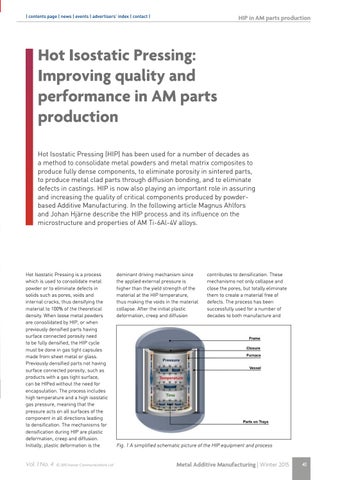| contents page | news | events | advertisers’ index | contact |
HIP in AM parts production
Hot Isostatic Pressing: Improving quality and performance in AM parts production Hot Isostatic Pressing (HIP) has been used for a number of decades as a method to consolidate metal powders and metal matrix composites to produce fully dense components, to eliminate porosity in sintered parts, to produce metal clad parts through diffusion bonding, and to eliminate defects in castings. HIP is now also playing an important role in assuring and increasing the quality of critical components produced by powderbased Additive Manufacturing. In the following article Magnus Ahlfors and Johan Hjärne describe the HIP process and its influence on the microstructure and properties of AM Ti-6Al-4V alloys.
Hot Isostatic Pressing is a process which is used to consolidate metal powder or to eliminate defects in solids such as pores, voids and internal cracks, thus densifying the material to 100% of the theoretical density. When loose metal powders are consolidated by HIP, or when previously densified parts having surface connected porosity need to be fully densified, the HIP cycle must be done in gas tight capsules made from sheet metal or glass. Previously densified parts not having surface connected porosity, such as products with a gas tight surface, can be HIPed without the need for encapsulation. The process includes high temperature and a high isostatic gas pressure, meaning that the pressure acts on all surfaces of the component in all directions leading to densification. The mechanisms for densification during HIP are plastic deformation, creep and diffusion. Initially, plastic deformation is the
Vol. 1 No. 4 Š 2015 Inovar Communications Ltd
dominant driving mechanism since the applied external pressure is higher than the yield strength of the material at the HIP temperature, thus making the voids in the material collapse. After the initial plastic deformation, creep and diffusion
contributes to densification. These mechanisms not only collapse and close the pores, but totally eliminate them to create a material free of defects. The process has been successfully used for a number of decades to both manufacture and
Fig. 1 A simplified schematic picture of the HIP equipment and process
Metal Additive Manufacturing | Winter 2015
41
